
- Home
- Memories
- Scrapbook ▽
- Topics ▽
- People ▽
- Events
- Photos
- Site Map
- Timeline
Page updated 18th March 2019
Return to Entertainment

In 1969, a collection of 23 boats and sailing craft belonging to Major David Goddard, were put on display, along with exhibits from other sources at a new Maritime Museum on Exeter quay and canal basin.
The museum was situated on 400 yards of waterfront, provided initially rent free, by Exeter City Council. It was intended that the museum would charter the ketch Result and keep her, along with the other large craft, as floating exhibits.
The museum was opened by Sir Alec Rose on 27th June 1969 - a group of sea scouts rowed Sir Alec up the canal in a replica of a royal barge that had been used in the film, A Man for all Seasons. The ISCA Trust (International Sailing Craft Association) sponsored the museum with the intention that the collection be used to educate young people and become an essential tourist attraction. At its opening the entrance fee was 3/6 for adults and 1/6 for children (17.5 pence and 7.5 pence).
Among the exhibits was a Pearling dhow presented by the Ruler of Bahrain, Shaikh Isa Bin Sulman Al Khalifa, the Kuwait Government gave a 120 ton 2-masted trading dhow, while a Reed boat from Lake Titicaca and some Welsh coracles were also among the initial displays. There were several boats moored in the canal basin including the steam tug St Canute, built in 1931 in Denmark. It had been purchased in 1960 by the Fowey Harbour Commission as a working boat.
When first opened, entrance to the museum was from the quay, with the museum using part of the two quay warehouses for exhibits and the ticket office. Butts Ferry was an integral part of the museum, to cross the river to the exhibits in the canal basin. In the 1980's the whole of the museum moved over to Haven Banks and vacated the quay. During the 1990's, the warehouses housing the museum on the canal basin needed repairs, causing financial problem, and the museum closed in 1997.
The museum moved part of the collection to the East Berwickshire fishing port of Eyemouth on the East Coast Scottish Border, and opened as the World of Boats. In 2017 it went into administration, and the collection was auctioned off.
Source - Official Maritime Museum guidebooks from 1969 and the Express and Echo - all photos by Alan H Mazonowicz unless otherwise stated.
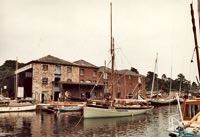 The Canal Basin
The Canal Basin
The Canal Basin was extensively used to show off historic boats at the
museum. The warehouses by the side of the basin also housed smaller
craft, displays, offices and a dry space for renovating the boats.
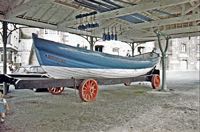 The Bedford Lifeboat
The Bedford Lifeboat
The first boat of the museum that the public would see when they
entered the quay was the Bedford lifeboat under the Transit Shed. The boat was built
from oak
planks fastened with copper, with added cork for buoyancy. Constructed
in 1886, she was in active service until the 1930's. She was presented
to the museum by the Tyne Lifeboat Society.
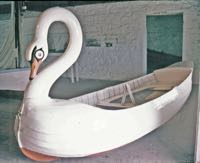 The Cygnet
The Cygnet
An oddity of a boat that was presented to the museum by Mr J H Cookson
of Liverpool. She was built as a tender to the larger 'Swan' in 1880. The Swan, in name
and shape, could seat sixteen for dinner. The Swan was destroyed by
fire, leaving only the Cygnet as a reminder of a certain type of
Victorian eccentricity.
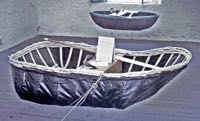 Welsh coracle
Welsh coracle
The museum had examples of the Welsh and Severn coracle and Irish
curraghs. They were lightly built boats that performed well in local,
choppy water. This example was of a Welsh coracle, probably built by J
C Thomas of Newcastle Emlyn.
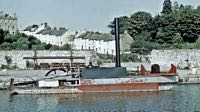 Brunel's steam dredger 'Bertha'
Brunel's steam dredger 'Bertha'
Built in Bristol during 1844, Brunel's dredger was the earliest steam
vessel in the museums collection, and the oldest working steamboat in
the world. It was designed for clearing mud from the Bridgewater Dock,
and was still working in 1964. British Rail presented her to the museum.
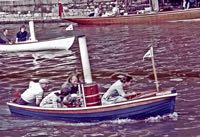 Steam Boat Rally
Steam Boat Rally
This was one of a number of steamboats that Alan H Mazonowicz
photographed at a, Museum organised, steam rally on the Exe.
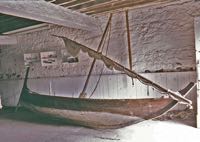 A sailing Dhow or shadoof
A sailing Dhow or shadoof
A small fishing craft that could be sailed or rowed, it had a unique
rudder, only to be found in the Gulf States. This one was presented to
the Museum by Gray McKenzie & Co Ltd.
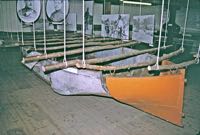 Portable boat
Portable boat
I can find no reference to this boat in any Museum publications.
However, looking at the photo, it looks like a conventional boat that
has been cut into sections to allow it to be carried, by hanging each
piece on a pole, of which each end is held by a porter.
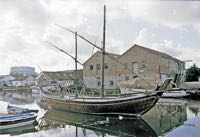 A pearling Dhow from Bahrain
A pearling Dhow from Bahrain
The museum was lucky enough to have several vessels presented to it
from various Gulf States. This pearling dhow was presented by the Ruler
of Bahrain, His Highness Shaikh Isa Sulman Al Khalifa. It needed a crew
of 30 or 40 men and boys, and was built of teak with soft iron nails.
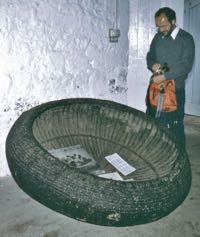 Iraqi Guffa
Iraqi Guffa
Although the photo is labeled shadoof, this is in all probability an
Iraqi Guffa. Designed for carrying passengers and cargo down the
Tigris, it was built of pomegranate stalks, twine and straw, it was
covered with pitch to waterproof it. It is an ancient design and was
first recorded by Herodotus four centuries before Christ. A shadoof is
a pivoted pole with a bucket at one end and a weight at the other, used
for drawing water from a well.
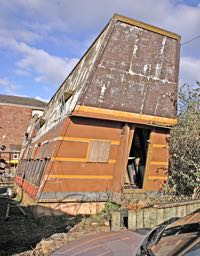 The King Harry
The King Harry
The Museum provided a play ship on the side of the canal basin for
children to play on. It had rigging and gun ports to lend authenticity.
The remains of the ship were left to rot after the Museum closed and
could still be seen in 2005 when this photograph was taken. Photo David
Cornforth.
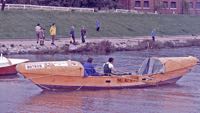 The QE3
The QE3
This boat, based on a Grand Banks Dory was rowed across the Atlantic in
1971, by cousins Don and Geoff Allum, in a time of 73 days. It was
one of several boats that were on display at the museum that had been
used to row across different oceans. They included the Super Silver,
Britannia II, and the ill fated Puffin.
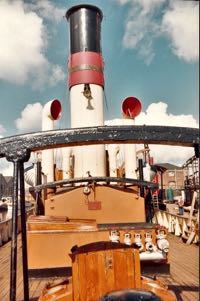
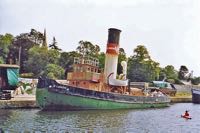 St Canute
St Canute
This was a working steam tug built in Denmark during 1931 for harbour
duties including service as an ice-breaker and fire fighter at Odense.
She was known as St Knud.
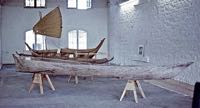 East African Dugout
East African Dugout
It origin of this canoe is not certain as it was picked up from the sea
in 1968 by HMS Gurka, off the East African Coast. It is probably a
fishing vessel from Kenya or Tanzania.
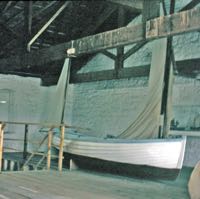 An Exe lugger
An Exe lugger
A small, clinker built boat with two sails that was used for fishing in
the Exe estuary. It would have been a common little work horse that was
used from Topsham to Exmouth and beyond.
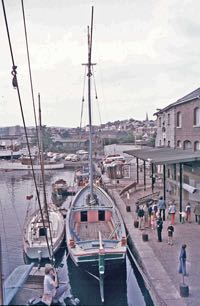 A Tagus lighter
A Tagus lighter
A general view of the Museum in the Canal Basin. The large boat is a
Tagus lighter, used to offload ships in Portugal. This photo was taken
in 1975, a year after it arrived at the Museum.
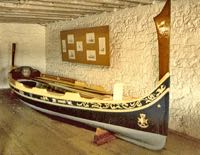 A Maltese djhajsa
A Maltese djhajsa
This is a traditional water taxi from Malta. The design of the djhajsa, along with another Maltese boat, the luzzu, may date back to Phoenician times. It was often used for ferrying passengers from ships to shore. It has been modified over time, especially when Malta was occupied by the British.
 Moliceiro
Moliceiro
A traditional moliceiro is a Portugues boat, which has brightly painted prows. They originate from the Ria de Aveiro, lagoon region of Rio Vouga. They were originally used to harvest the moliço, but are often used for tourism. Moliço is a type of sea grass that was used in agriculture.
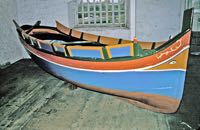 A Maltese Kajjik
A Maltese Kajjik
A kajjik is similar in appearance and function to the djhalsa (above) or luzzu, but has a square transom instead of a double-ended hull. They are smaller than the djhalsar. The are often used for regatta rowing racing.
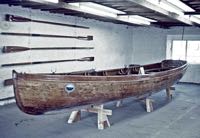 A Venetian gig
A Venetian gig
A gig used in Venice. Judging by the design, it was a general runabout for the locals.
│ Top of Page │